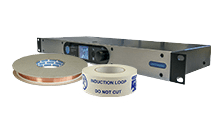Ampetronic 6 questions
Six questions to help Ampetronic design and specify loops
Providing as much information as possible on these six subjects will help us to prepare an accurate quotation or design as quickly as possible
1) Site Details
Ampetronic require a site name for any project. We will then allocate a unique project reference number – e.g. 105-106, which you can quote for any further enquiries about the project. It is also very useful for us to actually know what the project is, so we fully understand the way the loop system might be used.
2) Application / System Use
What type of system is needed? Is a local system required to assist communication across a desk or counter (e.g. in a bank), or will the loop need to cover a defined area? What inputs are needed – line level input (say from a mixing desk), microphone input and how many of each? Does your application include a performance stage/area, or are electric guitars and dynamic microphones likely to be used in or around the looped area?
3) Controlling Spill and Interference
A simple loop system will be audible for a considerable distance outside the loop. Is this likely to be a problem? For example, are there any other loop systems nearby (existing or planned)? Also, are there any issues of confidentiality? For example: Two classrooms next to each other will need a low spill design to minimise overhearing from one to the other. A council chamber used for confidential meetings may also require a low spill design. Is there a performance stage of area where electric guitars or balanced microphones are used which can interfere with the loop (and vice versa) which will require either a cancellation loop or low spill design. Please state in which directions the spill control is required.
4) Site Drawings
For a design to be created, Ampetronic will need a scaled plan of the room(s) showing basic outline and the area to be covered. Electronic drawings are acceptable in dwg format. If low spill designs are required, then the drawings should show the proximity of the rooms. If vertical spill is an issue, or the loop is intended to be installed at ceiling level, a section drawing may also be required.
5) Metal Structures
An appreciation of the amount and type of metalwork contained within or close to the loop area is very important in designing a loop system. If metal structures are not assessed your loop system may not work at all. Please provide any details that you have regarding floor or ceiling metalwork for example reinforcing mesh, metal system floors and suspended ceiling grids (for ceiling level loops) will all have an effect. For counters we need to know if the counter is all metal or does it have a metal front panel.
6) Installation Method
How and where are the loops going to be installed? Can single insulated cable be used, or will the loop be installed under a floor covering using flat copper tape? Note that rooms with metal loss or issues of low spill / confidentiality will need special design and the loop wires will cross the room at a number of points. Flat copper tape is usually the easiest to install under the carpet in this case, but alternatively, ordinary wire enclosed within plastic conduit may be installed either in the screed or above the suspended ceiling (depending on the height).
More information on the key issues that we consider in designing or quoting for a loop can be found in our Designing Induction Loops Guide which can be requested through the form below.



